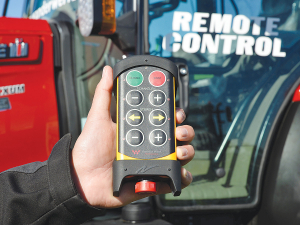Case IH Unveils New RB6 Round Balers & 2026 Square Baler Upgrades
Case IH has released details of its all-new round balers and redesigns to its large square balers aimed at increasing productivity.
 A remote-controlled unit allows cabbage and cauliflower growers to harvest without a driver seated in the tractor cab.
A remote-controlled unit allows cabbage and cauliflower growers to harvest without a driver seated in the tractor cab.
Dutch Case IH and Steyr tractor dealer, Van der Werf Mecanisatie – based at Zwaagdijk, north of Amsterdam – has developed a remote-control unit that allows cabbage and cauliflower growers to harvest without a driver seated in the tractor cab.
While self-propelled mechanical harvesters continue to make inroads, most Dutch growers continue to cut cabbages and cauliflowers by hand.
These are centred around placing the cut vegetables on lateral conveyors and a packing platform carried behind a tractor.
Typically operating at creep speeds as slow as 130m/hour, most growers use an extended cable behind the tractor to operate it remotely.
Van der Werf has taken the format a stage further and ditched the cable with a dedicated remote-control unit. Recently shown on a Case IH Maxxum 115 at a local machinery show, the conversion has been on offer for many years and the dealer reckons to have sold in excess of 100 systems, all over Holland – mainly to cauliflower growers.
Activating the system is said to be easy, with only three steps. After the tractor is started and set at idle, the operator engages the creeper gears and turns on the remote unit, which connects to an on-board receiver.
The remote can be programmed to only start the tractor and reverse it. However, most growers opt for a six-function configuration including stop, forward, gear changes or down and steering to the left or right. The remote system is only used when crossing a field, so headland turns are carried out by the operator.
The dealer notes that the Case IH Maxxum is the most popular tractor for the conversion but has also installed the kit on several New Holland and Steyr tractors.
The easiest conversion is for tractors with a mechanical transmission, with the dealer noting that CVT transmissions are very difficult to automate.
Depending on the tractor and the number of functions required, the cost of the conversion is typically around $7,000 to $8,500.
Farmer confidence has taken a slight dip according to the final Rabobank rural confidence survey for the year.
Former Agriculture Minister and Otaki farmer Nathan Guy has been appointed New Zealand’s Special Agricultural Trade Envoy (SATE).
Alliance Group has commissioned a new heat pump system at its Mataura processing plant in Southland.
Fonterra has slashed another 50c off its milk price forecast as global milk flows shows no sign of easing.
Meat processors are hopeful that the additional 15% tariff on lamb exports to the US will also come off.
Fears of a serious early drought in Hawke’s Bay have been allayed – for the moment at least.

OPINION: The release of the Natural Environment Bill and Planning Bill to replace the Resource Management Act is a red-letter day…
OPINION: Federated Farmers has launched a new campaign, swapping ‘The Twelve Days of Christmas’ for ‘The Twelve Pests of Christmas’ to…